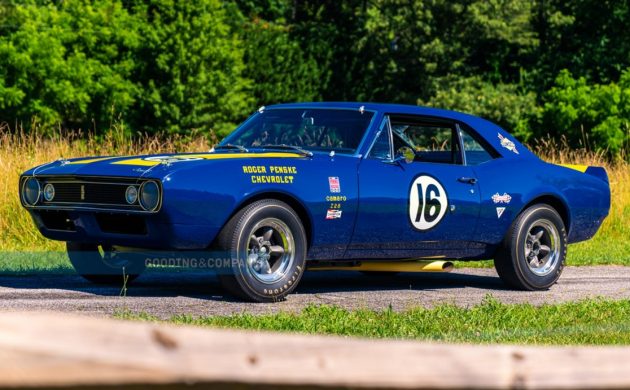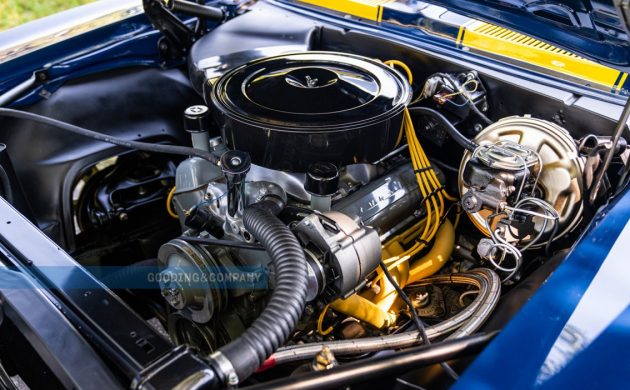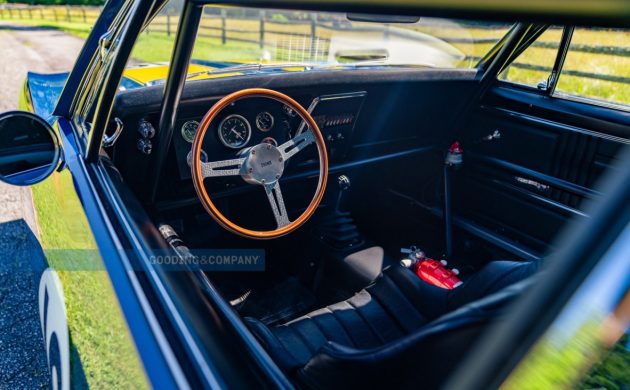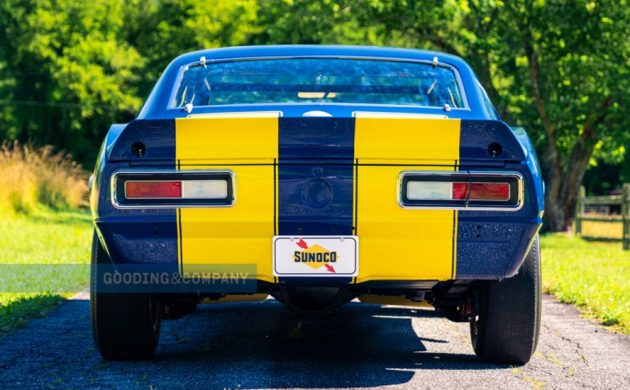There was a time in the early to mid-’70s when you encountered a first-gen Camaro Z28, there was a good chance that the original high-winding 302 CI engine had gone to that great machine shop in the sky. You’d find them with everything from soup to nuts under the hood, 283s, 327s, 350s, etc. – and I have a theory on that. But before expounding, let’s take a look at a restored 1967 Chevrolet Camaro Z28 replete in racing livery with the mechanical aptitude that was originally envisioned. This Camaro is available here on Gooding & Company’s website and will be auctioned at Pebble Beach, California on August 13 or 14. Thanks to Mitchell G for this tip!

The Camaro Z28 was envisioned as a road racer, a car that could effectively compete in the Sports Car Club of America’s (SCCA) Trans-Am road racing series. Of course, to do that in the under 5.0-liter class, Chevrolet had to sell a minimum number of production Z28’s with a 5.0-liter engine (302 CI) for homologation. And sell they did ultimately, though only 602 rolled off of Chevrolet’s Ohio and California assembly lines in model-year ’67. As for what happened to all those 302 CI V8’s – they got blowed up! Guys bought Z28’s and muscle car’d them on the street and pushed those diminutive and durable engines a little too hard. Stoplight to stoplight, or on the strip, the SS model would have been a better choice but the Z28 packed some pretty impressive engine componentry and internal mechanicals so it was a natural draw for the hot-rod set.
Our subject car is Z28 number 14 and ended up in Roger Penske’s race car shop where it was prepared for piloting by renowned driver Mark Donohue. This Camaro has been meticulously restored to its Sunoco livery – it’s a pretty far stretch from comparable racing series cars of today. It is almost understated and looks more like a ’60s street rambler, other than the displayed number 16, than a professional road course car. Beyond the missing bumpers, the exterior appearance mimics the production version, for the most part. Back in ’67, American Racing Wheels were actually used for racing!
The simplicity continues under the hood where a 302 CI V8 resides. Chevrolet’s 5.0-liter engine was basically a one-trick pony in that there was only a single version, and it singularly made its appearance in the Z28. In production for three years (’67-’69), it was rated at 290 gross HP, a number selected to keep it under the 300 HP trip-wire that launched high-performance car insurance premium surcharges. The engine, like the exterior, looks more streetable than full-bore race maven. The cowl induction air cleaner was actually sold over the counter at Chevrolet parts departments and I have seen a few on street cars. The “emission control” system caught my attention too, it’s a PCV valve with a hose, attached to the breather/oil fill tube, and shoved into a black plastic jug. I’m curious as to the horsepower output of this beast. A four-speed manual transmission gets the “go” to the Chevrolet twelve bolt differential.
The interior matches the vibe of the exterior. There is a custom instrument panel overlayed on top of the original panel but items like the door panels, window cranks, and door release handles are pure stock. Of note is the tachometer, installed so that 6,500 RPM resides at the twelve o’clock position. A racing seat has replaced the thin, original bucket variety while sheet metal has been substituted for the rear cushions. And of course, a roll cage has been installed. Oh, and no horn button on this Z, just a round metal plate engraved with an admonishment for the driver, it reads “THINK”.
Buy it and drive it? Unlikely, buy it and museum-it in a climate-controlled environment is more like it. This Camaro Z28 is a beautiful representation of U.S. road racing from a half-century ago. Hopefully, the new owner will display it in such a way and place that it can be seen and enjoyed by all.
All images copyright and courtesy of Gooding & Company. Photos by Brian Henniker







I am too poor to buy a car in the hope / expectation that it gains value over time. If I bought it I would drive it on occasion knowing that when I die I will have no use for money.
I’m confused. This is a “tribute” or “clone”? This does not appear to be an authentic Penske Camaro. Thanks.
Ad claims it’s the first of six Penske Camaro’s, so if I’m reading it right it’s the real deal.
The feature above leaves the impression it might be a fake. However, if you Google the portion of the VIN in the Hemming article you will find a slew of articles that give a definitive history of the car. It’s to be sold as part of a group of high profile race cars at that auction and has a pre-auction estimate of $1,400,000-2,000,000.
Will it be driven, no, it’s not a street car. Will it be raced, or at least spend time on the track at high profile exhibitions, more than likely, yes.
Steve R
I’m leaning toward “clone” or “tribute” In my opinion that is not a Trans Am engine compartment, air cleaner, steering wheel, or interior. I have the Mark Donohue book “The Unfair Advantage” and I don’t see any Penske Camaro that looked like the car featured in this article.
At some point Penske racing had their Camaro race cars acid dipped. Supposedly the bodys were paper thin. No mention of that happening with this one?
I’ve seen a few racing at the vintage tracks. Hopefully the over the top value won’t dissuade the racing of them.
Saying they were a one trick pony is a little daft.
The DZ motor was pretty amazing and is still held in high regards in the road racing circles. No mention about small vs large journal, the various cams offered..etc.
One trick pony means there was a single stock, 290 gross HP version used in a single-car, the Z28 – hardly daft.
JO
Definition of one-trick pony
: one that is skilled in only one area
also : one that has success only once
Right – skilled at road racing which is what it was designed to do. (I thought you weren’t going to read my posts anymore?)
JO
Just a skin-thickness measurement.
Is it thick enough yet? I’m glad you’re back.
JO
I would say it just right. Thanks!
While the performance of the 302 became the stuff of legend, so did its lack of durability. Since many people stuffed 350s into them, Chevy got wise and began installing 350s from the factory.
Ford had the same problem with the Boss 302, which gave way to the popular Boss 351.
Mopars had the 340, and when those died most of them were replaced with 318s. It was common to see “318 with 340 heads and cam” in For Sale ads in the 1970s.
the 67 Z28 “MO” & “MP” coded block was a one year only item. 2 bolt block with small main journals
the MO 302 that followed in 1968 was also a 2 bolt block, BUT with wide main journals
in 1969 they made 20,302 “DZ” 302 engines, 4 bolt block though, the wide/large journal carried over from 1968
yes, it is scary about all the facts I can spout on the 1st gen Camaro’s …
…also, these weren’t getting swapped due to blowing up. Considering every one of them had forged cranks, forged rods and was an over square design capable of 7000+ RPM in stock form, it was actually one of the most reliable/durable engines of the time. People yanked them because they had zero bottom end torque.
So for those people who lived their life a quarter mile at a time and couldn’t launch a car in the upper RPM (i.e. stop light racers) they yanked the high rev’ing 302 for the low end grunt of a big block or vanilla small block.
Around here (Pittsburgh) the most common cause of a blown engine (all makes) was a missed 2-3 power shift caused by the shifter hanging up in the gate. Rev limiters weren’t common with points and condenser ignition. Yanking an engine for tractability issues is not cheap, although back then SBCs were dirt cheap.
nice
Im a bit skeptical on this one myself but not enough to say its a fake. The track cars had a lower stance and the signage doesnt match what I remember it to be when I teched these cars back in tbe day.
I will guarantee that crankcase breather setup was not track legal because neither of the valve cover breathers run into the catch can(“black plastic jug”.
One thing about penske preparations: they were meticlious. I dont recall him ever outright breaking a rule but he loved operating in the gray areas. If the rules didnt say he couldnt do something then he would do it.
He kept his fuel in tanks on 6 to 10 foot towers to be able to fuel faster. When scca said that was illegal he started storing the fuel in dry ice to get more in in the same time
@ Shawn- Spot on. That is why the Donohue book is titled “The Unfair Advantage”
Every other racer about birthed a kitten when Penske & Donahue showed up with 4-lug wheels on their Javelins to save time during pit stops. I don’t think any rule was changed, but they only did it for a few races.
Having had one of these new, I do not recall the term Z28 in 1967 but instead they were referred to as a 302. Z28 followed in 1968.
But that was well over 50 years ago & senior moments are common now days.
No senior moment Gary, you are correct. The package was known as RPO Z28 but the car was not initially referred to as such. As a matter of fact, the earliest ’68s had a “302” badge on the leading edge of both front fenders and it was then switched, mid-model year to read “Z28”.
It’s sorta like Super Bowl I in ’67, it was renamed Super Bowl I after the fact, I believe after the ’69 competition between the Jets and the Colts. That game was named the Super Bowl and then referred to as Super Bowl III.
JO
The cowl induction air cleaner as well as headers were factory available options although both were shipped in the trunk for dealer installation.
The single variation of the 302 engine that I am aware of was the availability of a dual quad cross ram intake. I cant say how many were actually shipped but I do know not many were
None were shipped with the dual-quad set-up, it was an over-the-counter option that either the dealership or the owner could install. I’m not certain if it was covered by an RPO code.
This from Motor Trend details it:https://www.motortrend.com/features/camp-0810-1969-camaro-z28/
JO
This was destined to be a race car from they day it delivered. Penske would have had access to any OE parts they needed. As part of their race prep the entire drivetrain would have been torn down and “rebuilt/upgraded” as well as had the roll cage and other safety equipment installed prior to it turning a tire on the track.
Steve R
One guy, in our motorsports club, worked in GM Canada, and his dad worked much higher up, so he was an early employee “tester”. He took me for a ride in one of the first Z28s that GM guys were trying out, and it was always referred to as a Z28. It could move.
My family bought an early 68 new and it was no slouch even bone stock
The Z28,Cross Ram set came from the factory
with the set-up in the trunk on a small pallet in
1969.
That’s a common belief but I have never found proof of it. Do you have any evidence? Every source that I have researched, as in the Motor Trend article that I referenced, states that it was a dealer parts dept. supplied assembly.
JO
The Z28,Cross Ram set came from the factory
with the set-up in the trunk on a small pallet in
1969.
I dont know what it is but it is sitting about 4 inches too high all the way around to even think about a lap around a road course. the steering wheel would never had been run on a vintage race car .. the breather and power brake booster? this has got to be some street car built to look like a race car. IT is certainly not a trans am car . and I dont think Penske ever ran in the pure stock type classes that ran back i the day
You’re Mickey sits to high for a race car so maybe it was a Penske show car that would explain some of the stuff not being race spec
This may have been a show car but it wasnt built to race. All of the track cars had roll cage extending to the front of the front subframe to stabilize the frame as well as keeping the engine from being pushed back into the cockpit on impact
I just read the ad. I retract any statements regarding the provenance of this car. It was restored by Kevin MacKay of Corvette Repair, Valley Stream, New York. His specialty is meticulous research and restoration. Check out his website and the cars he has researched and restored.
There is a group of owner/racers of original T/A cars who tour a number of the most famous US road race circuits and run exhibition races as an opening act for a current competitive event. I was fortunate enough to get to watch them race before the Toyota 350 NASCAR road race at Sears Point (Sonoma Raceway) last month. The drivers and cars hung out in the cold paddock area after their fist exhibition event on Saturday to meet fans. It ended up being the highlight of the weekend for me. It was especially nostalgic for me because my Father had taken me to see these guys race at Laguna Seca in April of 1970. So it was incredibly cool to see the very same cars on display that I salivated over in my innocent youth. Note that these are not clones, replicas or re-creations, but the actual surviving Trans-Am cars that ran in the series between 1966 and 1972.
Being a Mopar guy, I was most enamored to see Sam Posey’s #77 Challenger T/A from 1970. But I couldn’t help but notice the crowd formed around the #6 Penske Camaro parked next to the Challenger It turns out that this was the actual car Mark Donahue had raced to the Trans Am championship victory in 1969 before he and Penske defected to AMC. The car is replete with the cross ram 302, and yes it really was acid dipped. I didn’t get a chance to talk to the owner, but I heard from another driver that he had recently turned down a cash offer of $3M for the car. Not shocking considering the significance of this particular T/A Camaro. What is shocking is me is that these are NOT treated as museum pieces. These guys are out there racing them hard every time they do an exhibition.
I don’t know how much this ’67 specimen will cross the block for. But IMHO, it if is as authentic as it looks it would not surprise me a bit to see it go for a high six figure number. Whether it has racing provenance or not, as an early Penske TA Camaro it’s certainly historically significant.
Here is the display placard with the backstory on the 1969 Donahue Camaro in the previous picture.
350’s, 327’s, ha…
Scanning the local Autotrader magazine back in the early eighties I remember more than a few early Z/28’s stuffed with 454’s and maybe a high revving 427, looking to sell maybe ’cause of the all new biannual smog check in California!?
Does anyone know how much it sold for? I tried to find out on the auction website but didn’t have any luck.
I don’t think it sold. Looking at other cars in the auction, you can see they are listed with the hammer price. This one still shows the estimated range of $1.4M to $2M